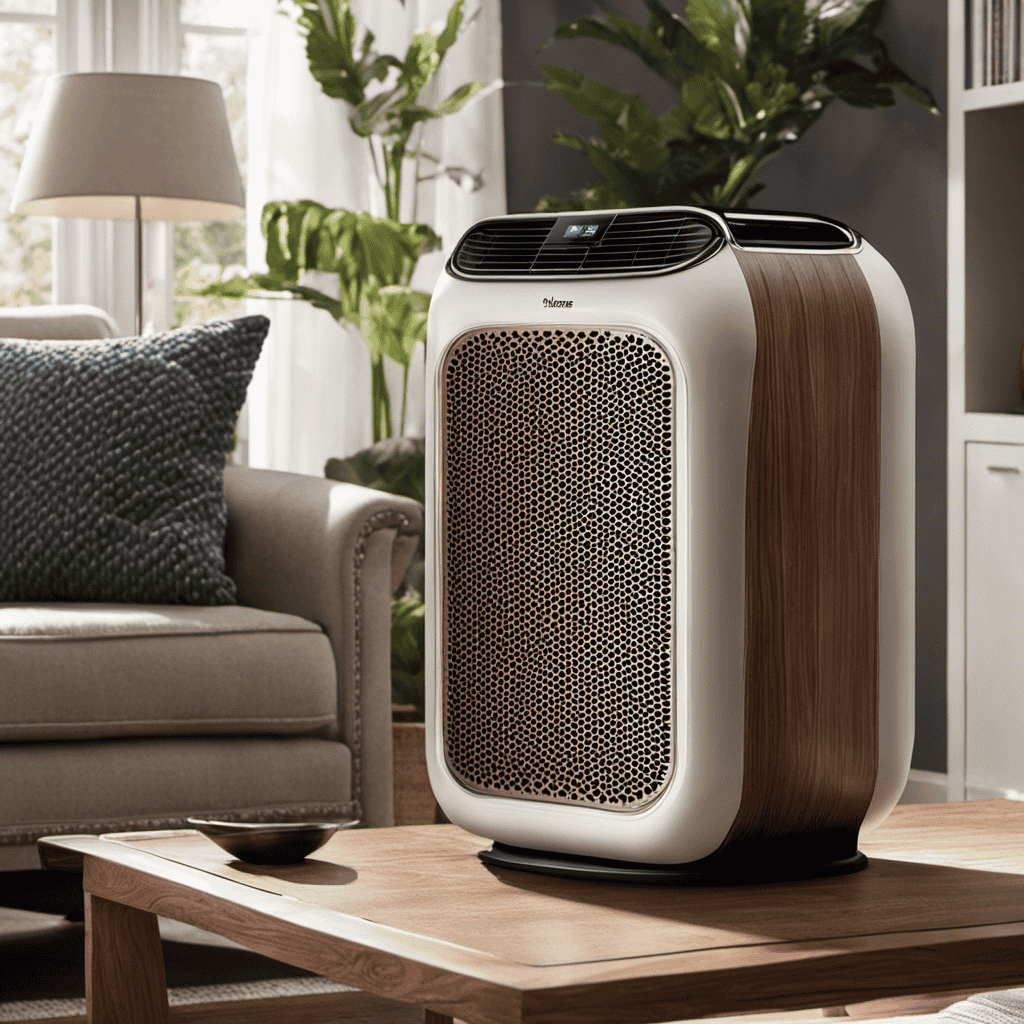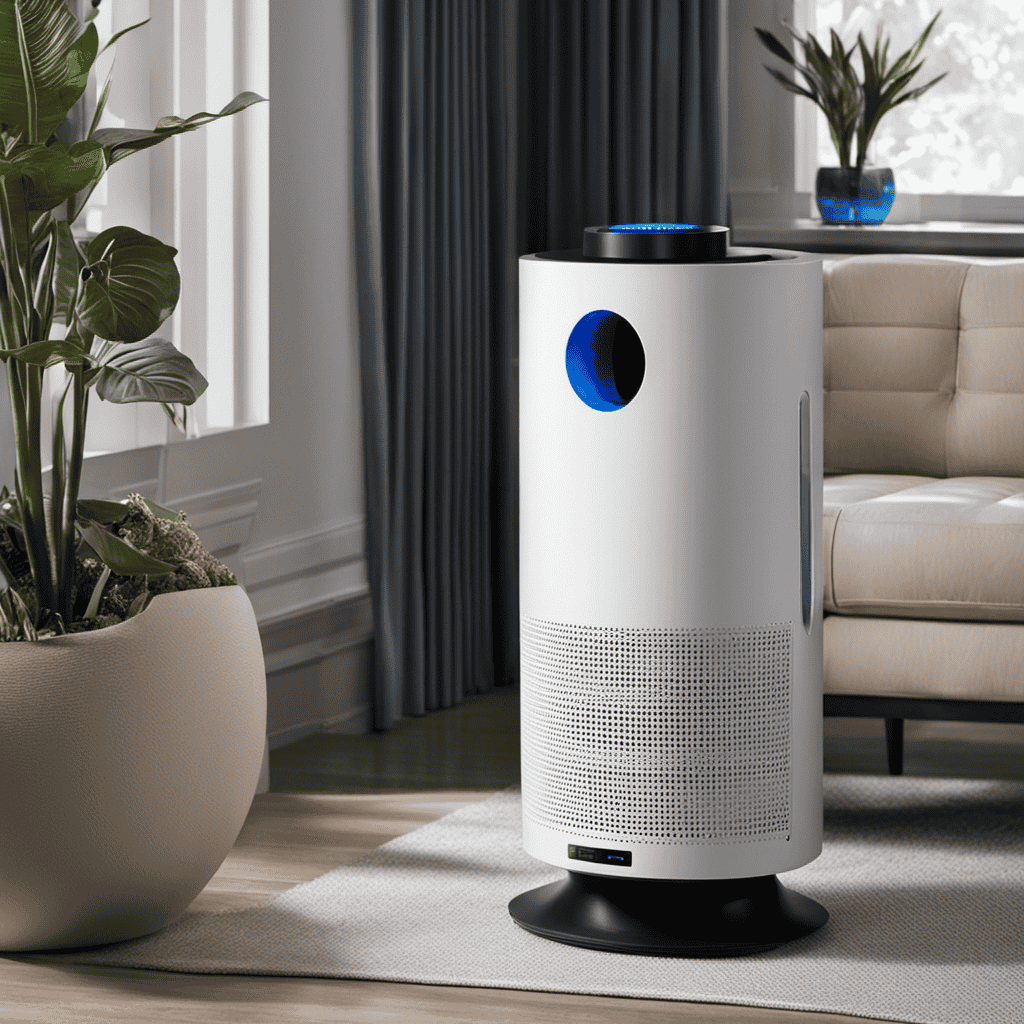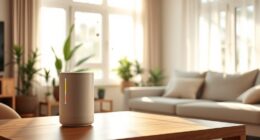As someone who is passionate about air quality, I have learned the importance of keeping the air indoors clean for our well-being.
So, let’s talk about air purifiers and the often overlooked aspect of filter replacement.
Just like a clogged drain can’t do its job effectively, a dirty filter can’t remove pollutants efficiently.
In this article, we’ll explore the factors to consider, signs it’s time to change the filter, and tips for extending its lifespan.
So, let’s dive in and breathe easy!
Key Takeaways
- Regularly cleaning or replacing the filter is crucial for optimal performance and effective pollutant removal.
- Recognizing signs of a dirty filter, such as reduced airflow and decreased air quality, is important for timely replacement.
- Following manufacturer’s guidelines for replacement intervals and using pre-filters can help extend the lifespan of the main filter.
- Filter replacement indicators, air quality readings, and monitoring pollutant levels can help determine when to change the filter.
Factors to Consider
When deciding how often to change the air purifier filter, there are a few factors to consider.
Filter maintenance and filter cost are two important aspects that should be taken into account. Proper filter maintenance is crucial for the optimal performance of an air purifier. Regularly cleaning or replacing the filter ensures that it can effectively capture and remove pollutants from the air. Neglecting filter maintenance can result in reduced air quality and strain on the air purifier, leading to decreased efficiency and potentially higher energy costs.
Another factor to consider is the cost of the filter itself. Different air purifier models require different types of filters, and their prices can vary significantly. It is essential to choose a filter that fits your budget without compromising on quality. Some filters may need to be replaced more frequently than others due to their design or the level of pollutants in your environment. Considering the lifespan of the filter and its replacement cost can help you make an informed decision.
Taking both filter maintenance and filter cost into account, it is crucial to find a balance that ensures optimal air quality without incurring unnecessary expenses. By considering these factors, you can determine how often you should change your air purifier filter to maintain a clean and healthy indoor environment.
Recommended Filter Lifespan
When it comes to air purifiers, understanding the recommended filter lifespan is crucial. The filter replacement frequency can vary depending on factors such as air quality, usage, and the specific model of the air purifier.
It is important to recognize the signs of a dirty filter and take steps to extend its lifespan, ensuring optimal performance and cleaner air in your environment.
Filter Replacement Frequency
The frequency at which you should change the air purifier filter depends on its usage and the manufacturer’s recommendations. Following a recommended replacement schedule has several benefits:
- Improved Air Quality: Regularly changing the filter ensures that it can effectively capture and remove pollutants from the air, resulting in cleaner and healthier air for you to breathe.
- Increased Efficiency: A clean filter allows the air purifier to operate more efficiently, maximizing its performance and ensuring optimal filtration.
- Prolonged Lifespan: By regularly replacing the filter, you can extend the lifespan of your air purifier, saving you money in the long run.
Changing the air purifier filter on time is essential to maintain its effectiveness. However, how do you know when it’s time to replace it? Let’s explore the signs of a dirty filter in the next section.
Signs of Dirty Filter
To determine if your air purifier’s filter is dirty, you can look out for specific signs such as reduced airflow and a noticeable decrease in air quality. Proper filter maintenance is crucial for optimal filter performance.
Over time, filters accumulate dirt, dust, and other pollutants from the air, which can hinder their effectiveness. Reduced airflow occurs when a filter becomes clogged with debris, making it harder for air to pass through. This can lead to a decrease in air quality as the filter is unable to capture and remove airborne particles effectively.
Regularly checking and cleaning or replacing your air purifier’s filter is essential to ensure that it functions efficiently and effectively in improving indoor air quality.
Extending Filter Lifespan?
Regularly cleaning or replacing your air purifier’s filter can help extend its lifespan. Proper filter maintenance is crucial in ensuring optimal performance and longevity of your air purifier. Here are three important tips to prolong your filter’s life:
-
Clean the filter regularly: Dust and debris accumulate on the filter over time, reducing its efficiency. Regularly vacuuming or rinsing the filter can help remove these particles and prevent clogging.
-
Follow the manufacturer’s guidelines: Every air purifier has specific instructions for filter replacement. Follow these guidelines to ensure you are replacing the filter at the recommended intervals.
-
Consider pre-filters: Pre-filters are an additional layer of protection for your main filter. They capture larger particles, reducing the workload on the main filter and extending its life.
Signs It’s Time to Change the Filter
When it comes to maintaining optimal air quality in your environment, it’s crucial to regularly replace the filters in your air purifier.
Filter replacement indicators are an essential feature that helps you determine when it’s time for a change. These indicators monitor the lifespan of the filter and provide a timely reminder based on factors such as usage and air quality changes.
Filter Replacement Indicators
You should check the filter replacement indicators on your air purifier regularly to ensure that you know when to change the filter. Here are some tips to help you with filter maintenance:
-
Look for an indicator light: Many air purifiers have a built-in indicator light that will illuminate when it’s time to replace the filter.
-
Monitor air quality readings: Some advanced air purifiers have sensors that measure the air quality in real-time. When the air quality drops below a certain threshold, it’s a sign that the filter needs to be replaced.
-
Keep track of usage hours: Some air purifiers have a timer that tracks the number of hours the filter has been in use. Once a certain number of hours is reached, it’s time to change the filter.
Regularly checking the filter replacement indicators will save you money in the long run by avoiding unnecessary filter replacement costs. It’s important to stay on top of filter maintenance to ensure optimal performance and clean air in your home.
Speaking of clean air, let’s now discuss changes in air quality.
Changes in Air Quality
Monitoring the air quality readings is a helpful way to determine if the filter needs to be replaced. Air pollution, caused by various pollutants such as particulate matter, carbon monoxide, and volatile organic compounds, can have detrimental effects on our health.
Breathing in polluted air can lead to respiratory problems, cardiovascular diseases, and even cancer. Regularly checking the air quality readings can provide valuable insights into the level of pollutants present in your environment.
If the readings consistently show high levels of pollutants, it may indicate that the air filter in your purifier is no longer effective in removing these harmful particles. Replacing the filter at this stage is crucial to ensure that you breathe clean and healthy air, minimizing the potential health risks associated with air pollution.
Understanding Filter Types
To better understand filter types, it’s important to research and educate yourself on the different options available. Here are three key factors to consider:
-
Different filter materials: Filters can be made of various materials such as fiberglass, pleated fabric, or activated carbon. Each material has its own strengths and weaknesses in terms of capturing different types of particles.
-
Understanding MERV ratings: MERV stands for Minimum Efficiency Reporting Value, which is a rating system that measures the effectiveness of air filters in trapping airborne particles. The higher the MERV rating, the more efficient the filter is at capturing smaller particles.
-
Filter efficiency affects replacement frequency: The efficiency of a filter plays a significant role in how often it needs to be replaced. Filters with higher MERV ratings tend to last longer and capture more particles, but they may also restrict airflow more quickly. It’s important to strike a balance between efficiency and airflow to ensure optimal performance.
By considering different filter materials and understanding MERV ratings, you can make an informed decision on which filter type suits your needs best.
In the next section, we will delve into how filter efficiency affects replacement frequency, helping you determine when it’s time to change your air purifier’s filter.
How Filter Efficiency Affects Replacement Frequency
Understanding the relationship between filter efficiency and replacement frequency is crucial for maintaining optimal performance in your air purifier. The efficiency of an air purifier’s filter determines how effectively it can remove pollutants from the air. As filters become clogged with particles, their efficiency decreases, and they need to be replaced to maintain the air purifier’s performance.
To illustrate this relationship, consider the following table that showcases the impact of filter efficiency on replacement frequency:
| Filter Efficiency | Replacement Frequency |
|---|---|
| Low (50%) | Every 1-2 months |
| Medium (70%) | Every 3-4 months |
| High (90%) | Every 6-12 months |
As you can see, the higher the filter efficiency, the longer you can go without replacing it. This not only saves you money but also extends the lifespan of the filter. However, it’s important to note that these replacement frequencies are general guidelines and may vary depending on factors such as the level of pollution in your area and the usage of your air purifier.
To further extend the lifespan of your filter and maintain its efficiency, here are some filter maintenance tips:
- Regularly vacuum the outer surface of the filter to remove larger particles and debris.
- Follow the manufacturer’s instructions for cleaning or replacing the pre-filter, if applicable.
- Keep your air purifier in a clean environment to minimize the accumulation of dust and dirt on the filter.
- Monitor the air quality in your surroundings and adjust the replacement frequency accordingly.
Tips for Extending Filter Lifespan
Here are some tips to help you prolong your filter’s lifespan and maintain its efficiency:
-
Regular Cleaning: Regularly clean your air filter to remove dust, pollen, and other particles that can clog the filter and reduce its effectiveness. Use a vacuum cleaner or wash the filter with water and mild soap. Make sure to let it dry completely before reinstalling.
-
Proper Placement: Place your air purifier in an area with good airflow. Avoid placing it near walls or furniture that can obstruct airflow and cause the filter to work harder.
-
Filter Replacement: In addition to regular cleaning, replace your filter when necessary. Follow the manufacturer’s recommendations for filter replacement to ensure optimal performance.
By following these filter maintenance techniques, you can extend the lifespan of your air purifier filter and maintain its efficiency.
Regular cleaning and proper placement will help prevent clogging and ensure proper airflow. Timely filter replacement will ensure that your air purifier continues to effectively remove pollutants from the air.
Different Purifier Brands and Their Filter Recommendations
In my research on air purifier maintenance and filter effectiveness, I also wanted to explore the different recommendations provided by various purifier brands for filter replacement. It is important to note that each brand may have its own specific guidelines, so it’s always best to refer to the manufacturer’s instructions for your particular model. However, I have compiled a table below to give you a general idea of how often some popular purifier brands recommend changing filters:
| Brand | Filter Type | Recommended Replacement Interval |
|---|---|---|
| Brand A | HEPA | Every 6 months |
| Brand B | Carbon | Every 3 months |
| Brand C | Pre-filter | Every 1 month |
| Brand D | HEPA + Carbon | Every 6-12 months |
| Brand E | True HEPA | Every 12 months |
| Brand F | HEPA + Pre-filter | Every 6 months |
Please keep in mind that these intervals may vary depending on factors like air quality, usage, and the specific model of your purifier. It is crucial to regularly check and maintain your air purifier to ensure its optimal performance. Remember, a clean and effective filter is essential for capturing and removing airborne pollutants, allergens, and odors from your indoor environment.
The Role of Air Quality in Filter Lifespan
Regularly checking and maintaining your air purifier is crucial to ensure optimal performance and extend the lifespan of your filters. Proper filter maintenance is essential for effective air purification and for keeping your indoor air clean and healthy.
Here are three important points to consider when it comes to filter maintenance:
-
Regular Cleaning: Dust and debris can accumulate on the surface of your air purifier’s filters over time, reducing their efficiency. Regularly cleaning the filters helps to remove these particles and restore their effectiveness.
-
Replacing Filters: Filters have a limited lifespan and need to be replaced periodically. The frequency of replacement depends on various factors, including the manufacturer’s recommendations and the level of outdoor pollution in your area.
-
Monitoring Air Quality: Outdoor pollution can have a significant impact on the lifespan of your air purifier’s filters. Monitoring the air quality in your area can help you determine when it’s time to replace the filters and ensure that your purifier is working optimally to combat the pollutants.
Common Mistakes to Avoid When Changing the Filter
To ensure optimal performance and extend the lifespan of your filters, it’s important to avoid common mistakes when replacing them.
There are several factors to consider when changing the filter in your air purifier. First, make sure you are using the correct filter for your specific model. Using the wrong filter can lead to reduced efficiency and performance.
Additionally, it’s crucial to follow the manufacturer’s guidelines for filter replacement intervals. Changing the filter too frequently or not often enough can both have negative effects on the filter’s lifespan.
Another mistake to avoid is neglecting to clean or replace the pre-filter. The pre-filter helps to capture larger particles and prolongs the life of the main filter. Regularly cleaning or replacing the pre-filter is essential for maintaining the overall effectiveness of your air purifier.
Finally, be cautious when handling the filters. Avoid touching the filter material directly, as this can transfer oils and dirt onto the filter, reducing its efficiency.
Frequently Asked Questions
Are All Air Purifier Filters Interchangeable or Do They Vary Depending on the Brand and Model?
Air purifier filters can vary depending on the brand and model. Not all filters are interchangeable, as they have different sizes, shapes, and designs.
It is crucial to check the compatibility of the filter before purchasing or replacing it. Using an incompatible filter may result in reduced efficiency or damage to the air purifier.
Always refer to the manufacturer’s recommendations and specifications to ensure the correct filter is used for your specific air purifier model.
Is It Necessary to Replace the Pre-Filter as Frequently as the Main Filter?
Replacing the pre-filter is an important part of air purifier maintenance. While it may not need to be replaced as frequently as the main filter, it still plays a vital role in capturing larger particles and prolonging the lifespan of the main filter.
Neglecting to replace the pre-filter regularly can lead to reduced air filtration efficiency and potentially increase the cost of replacement filters in the long run. Therefore, it is recommended to follow the manufacturer’s guidelines for pre-filter replacement.
Can I Clean and Reuse the Filters Instead of Replacing Them?
Cleaning filters is an important part of maintaining an air purifier. However, it is not recommended to clean and reuse filters instead of replacing them. Filters have a limited lifespan and may not function effectively after being cleaned.
Replacing filters ensures optimal performance and improves air quality. It is advisable to consult the manufacturer’s instructions for specific filter replacement intervals based on usage and environmental conditions.
How Do I Know if My Air Purifier Has a Filter Replacement Indicator?
To know if your air purifier has a filter replacement indicator, look for a light or warning symbol on the device or check the user manual.
It’s important to clean air purifier filters regularly to maintain their efficiency. You can use a vacuum or rinse them with water, but avoid using chemicals or soap.
Additionally, extending the life of air purifier filters can be done by keeping the unit in a clean environment and avoiding excessive dust and dirt.
Can I Use Generic or Off-Brand Filters Instead of the Manufacturer’s Recommended Filters?
Using generic or off-brand filters instead of the manufacturer’s recommended filters can have both pros and cons.
The main advantage is that generic filters are often more affordable, making them a budget-friendly option. However, they may not fit as snugly or filter the air as effectively as the manufacturer’s filters.
To find affordable air purifier filters, consider looking for sales or discounts, and compare prices from different retailers. Don’t forget to check the filter’s compatibility with your specific air purifier model.
Conclusion
In conclusion, maintaining clean air is crucial, and regularly changing your air purifier filter plays a pivotal part.
By understanding the factors that affect filter lifespan, recognizing the signs of a worn-out filter, and choosing the right filter for your specific needs, you can ensure optimal air quality in your space.
Remember, filter efficiency directly impacts replacement frequency, so investing in a high-quality filter can save you time and money.
Don’t neglect your filter’s maintenance; it’s the key to fresh and filtered air!










